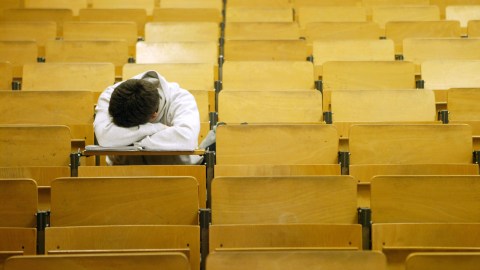The #1 Reason for Poor Student Performance

One of today’s most contentious public debates involves education reform. Teachers, parents, researchers, and legislators recognize the American school system needs an overhaul, or at the very least an injection of some immensity. While Americans like to fancy themselves leaders by default, standardized test scores are consistently lagging on a global scale.
Economic disparity is first to mind. As Paul Tough writes, a majority of public school students fell below the government’s low-income cutoff for the first time in 2013. And yet, income level is, on its surface, a poor indicator of scholastic performance. Increased spending by school districts and economic incentive programs yield mediocre results. One study by the Organization for Economic Cooperation and Development found that national financial investments in education account for less than 10 percent in overall performance. The United States spends more of its GDP on higher education than any other nation, yet in 2009 fourteen developed countries graduated a larger percentage of students from college.
In 2007 the consulting firm McKinsey investigated twenty-five of the best performing school systems in the world. It found three key factors in performance:
How about students, however? As it became clear that income was not the driving factor, character development became the clarion call. What those kids need, like Calvin’s father repeatedly expressed, is a strong dose of fortitude to develop that nebulous quality strong leaders longingly claim as their own. Indeed, noncognitive skills, such as social awareness and self-management, are valuable indicators of improved performance.
In his article, Tough steps back to muse over what would stop character formation. His answer is clear: stress. Students from non-supportive and even violent households and environments—which is where, at least in some cases, economics does come into play—are unable to develop higher-order thinking skills. Given that the human brain is nearly formed by age six, but then takes another two decades to become fully myelinated—the fatty layer of insulation that connects all neural networks—teenagers are much more likely to act out emotionally than rationally. A negative feedback loop ensues, in which parents or teachers tell kids they’re not worthy. Since their fight-flight-freeze system is already on high alert, an imaginary tale in which the school, teachers, and system are in cahoots is written into their personal narrative and acted out.
While the system may or may not be implicated in creating such conditions, it certainly is not equipped for rehabilitation or counseling. Like the American prison system—another example of a stress-inducing existence in which the basic tenets of trust and respect are consistently trampled by lizard brain aggressions—educators are left no recourse but to punish bad behavior. Sadly, much of this behavior is non-violent or threatening. As Tough writes, 60 percent of Chicago’s out-of-school suspensions in public schools were for talking back, disruptive behavior, or violating school rules.
None of the above behavior should be championed, of course, nor is coddling an answer. But growing research in neuroscience and developmental psychology has the potential to foster new understanding in how we educate children. While traumatic episodes in infancy are difficult to overcome, they are not death sentences; neural plasticity implies a lifelong process, one that educators need to factor in when confronting student issues.
While cross-cultural comparisons are always nuanced—any time I post about successes in other countries I receive a litany of ‘but’s’—research in Finland, a country with high performing students across economic levels, is promising. Peter C Whybrow cites three factors critical in the nation’s success:
Students do not enter elementary school until the age of seven; the day is shorter than in most schools in the United States or Britain; and creative, playful engagement with the natural world is encouraged.
Part of this backs up Tough’s theory that stress is the top factor of performance. And yet, as much as I enjoyed his article—and perhaps his book brings up the following details—I was surprised that a nine-page feature in the Atlantic would not entertain one of the most important factors for stress management: exercise.
This is especially startling considering how often Tough references the Chicago public school system, which is also home to the suburban Naperville system and its Zero Hour PE program. The elective before-school cardio session has produced credible results. As John J Ratey reports, at the end of the first semester students showed a 17 percent improvement in reading and comprehension, while those that slept in increased 10.7 percent. Students that partake report feeling more energetic and focused, especially when their hardest classes are during first and second periods—increased blood flow has its advantages, but wanes by lunchtime.
The disconnection between brain and body is constant in education discussions. The programs cut first are physical education and the Arts, which is counter to Finland’s ‘creative, playful engagement with the world.’ This is impossible if, beginning at the age of five, you spend six to eight hours a day seated in uncomfortable desks being thrown facts that will probably mean nothing for the rest of your life. Factor in nutrition—another element missing in the Atlantic piece—and you create tribes of over-sugared, under-utilized bodies not at home with their brains because they’re essentially being treated like prisoners. Sit still, eat this, and memorize!
This is where education fails, time and again: a complete lack of engagement with the physical world. This does not contradict Tough’s article. If anything, it only clarifies it, as two of the greatest catalysts of stress are misused bodies and sugar-rich diets. It makes sense that some children, with the proper stressors, would grow discontent and even violent: they have no outlet for physical or creative expression. While aspects of behaviorism, collaboration, and feedback that Tough cites are all necessary counterforces to the ravages of chronic anxiety, until we factor in mindfulness training, movement, and diet, we’re never going to see the complete picture of this complex issue.
—
Image: Sean Gallup / Getty Images
Derek Beres is a Los-Angeles based author, music producer, and yoga/fitness instructor at Equinox Fitness. Stay in touch @derekberes.





